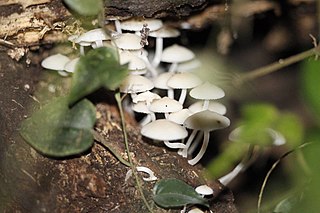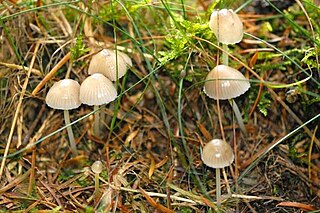
Roridomyces roridus, commonly known as the dripping bonnet or the slippery mycena, is a species of agaric fungus in the family Mycenaceae. It is whitish or dirty yellow in color, with a broad convex cap 5–15 mm (0.2–0.6 in) in diameter. The stipe is covered with a thick, slippery slime layer. This species can be bioluminescent, and is one of the several causative species of foxfire.
Neonothopanus is a genus of three species of fungi in the agaric family Omphalotaceae. The genus was circumscribed in 1999. The type species N. nambi is found in Australia, South America, Central America, and Malaysia, while N. gardneri is found in South America. Both of these species are bioluminescent. N. hygrophanus, found in central Africa, was added to the genus in 2011.
Neonothopanus gardneri, locally known as flor de coco, is a bioluminescent fungus native to Goiás, Piauí and Tocantins states in Brazil.
Mycena asterina is a species of agaric fungus in the family Mycenaceae. It is found in São Paulo state, Brazil, where it grows singly or scattered on fallen leaves in Atlantic forests. The fruit bodies of the fungus are bioluminescent.
Mycena discobasis is a species of agaric fungus in the family Mycenaceae. Found in South America and Madagascar, the fruit bodies of the fungus are bioluminescent.
Mycena fera is a species of agaric fungus in the family Mycenaceae. Found in South America, the fruit bodies of the fungus are bioluminescent.
Mycena lacrimans is a species of agaric fungus in the family Mycenaceae. Found in South America, the fruit bodies of the fungus are bioluminescent.

Mycena illuminans is a species of agaric fungus in the family Mycenaceae. It was first found on the trunk of Calamus (palm) in Jawa, Indonesia. It is bioluminescent.

Mycena tintinnabulum is a European species of agaric fungus in the family Mycenaceae. The mycelium, but not the fruit body, is bioluminescent.

Mycena zephirus is a species of agaric fungus in the family Mycenaceae. It is bioluminescent.
Mycena sublucens is a species of agaric fungus in the family Mycenaceae. Found in Indonesia, it was described as new to science in 1954 by English mycologist E. J. H. Corner. The fruit bodies are bioluminescent.

Mycena singeri is a species of agaric fungus in the family Mycenaceae. Described as new to science in 1988 by Jean Lodge, it is bioluminescent. In 2007, the first reported luminescent species were found from a single site in primary Atlantic Forest habitat in the Alto Ribeira Tourist State Park, São Paulo State, Brazil.
Mycena pseudostylobates is a species of agaric fungus in the family Mycenaceae. It is bioluminescent. It was originally found on the leaves of Quercus gilva in Japan.

Mycena olivaceomarginata is a species of agaric fungus in the family Mycenaceae. Originally described as Agaricus olivaceomarginata by English mycologist George Edward Massee in 1890, he transferred it to Mycena in 1893. Found in Europe and North America, the mycelium of the fungus is bioluminescent.
Mycena noctilucens is a species of agaric fungus in the family Mycenaceae. The species was first described scientifically by E.J.H. Corner in 1954. Found in Malaysia and the Pacific islands, the mycelium of the fungus is bioluminescent.
Nothopanus noctilucens is a species of agaric fungus in the family Marasmiaceae. Found in Japan, the fruit bodies of the fungus are bioluminescent.
Omphalotus mangensis is a species of agaric fungus in the family Marasmiaceae. Found in China, the fruit bodies of the fungus are bioluminescent.
Poromycena hanedai is a species of agaric fungus in the family Mycenaceae. Found in Japan, the species was first described by Kobayasi in 1951. It is bioluminescent.
Mycena daisyogunensis is a species of agaric fungus in the family Mycenaceae. The fruit bodies of the fungus are bioluminescent. It was collected from Daisyogun Cave in Miyazaki Prefecture on Kyushu, Japan.





